15 Most Common Types of Butterflies in North Carolina (With Pictures)
-
Jeff Weishaupt
- Last updated:

North Carolina is home to more than 175 butterfly species with varying characteristics and colors. The state’s wide range of habitats makes it a hotspot for butterflies. Whether you visit coastal dunes or forests, you’re likely to encounter one or more species.
North Carolina’s wetlands, sandhills, and mountain ranges are covered with flowering vegetation, and that’s no less than heaven for butterflies. If you’re planning to visit North Carolina and look for colorful butterflies, you should know their identification signs and behavior. For your ease, this guide lists 15 common types of butterflies in North Carolina. So, let’s explore them!
The 15 Most Common Types of Butterflies in North Carolina
1. Little Yellow

| Scientific Name: | Eurema lisa |
| Wingspan: | 1 to 1.5 inches |
| Lifespan: | 3 to 11 months |
As evident from their name, Little Yellow butterflies are yellow with dark spots on their wings. They are found across the state but rarely in the central and western regions. Some butterflies may also have dark borders on their wings.
To spot Little Yellow butterflies in North Carolina, you should visit dry, open habitats, especially sandy or abandoned areas. In their caterpillar stage, these species feed on the wild plants included in the Pea family. As they turn into adults, they sit on flowering plants from the Aster family.
2. Common Buckeye

| Scientific Name: | Junonia coenia |
| Wingspan: | 1.6 to 2.75 inches |
| Lifespan: | 2 to 4 weeks |
The Common Buckeye is a brown-colored butterfly species with beautiful patterns on its wings. You’ll find around six eyespots and multiple orange bars on these butterflies. Out of six, four eyespots are large and colorful.
To meet the Common Buckeye, you’ll have to visit North Carolina’s sunny, open fields and suburban backyards. They like staying on bare ground with low vegetation.
Common Buckeyes prefer plants belonging to the Snapdragon and Plantain families in the caterpillar stage. As they grow older, they love feeding on the nectar of aster, dogbane, gumweed, tickseed sunflower, peppermint, and chicory flowers.
3. Cabbage White
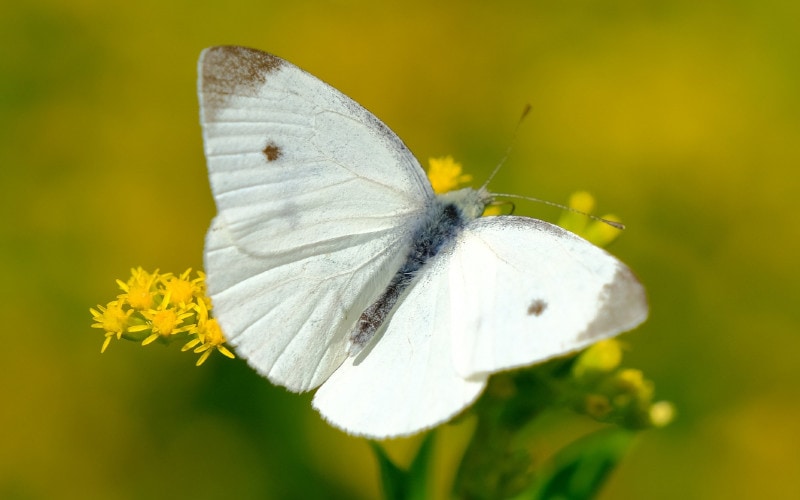
| Scientific Name: | Pieris rapae |
| Wingspan: | 1.75 to 2.25 inches |
| Lifespan: | 1 to 3 weeks |
Cabbage White is a common white butterfly species in North Carolina. You’re likely to see these butterflies in every part of the state. This beautiful species is white with distinctive grayish-green and yellowish-green undersides.
You may also find dark spots on the Cabbage White’s wings. Their caterpillars are thin and green and love to feed on plants from the Caper and Mustard families. In the adult stage, these butterflies feed on the nectar of different flowers, including mustards, dandelions, red clovers, mints, and asters.
4. Orange Sulphur
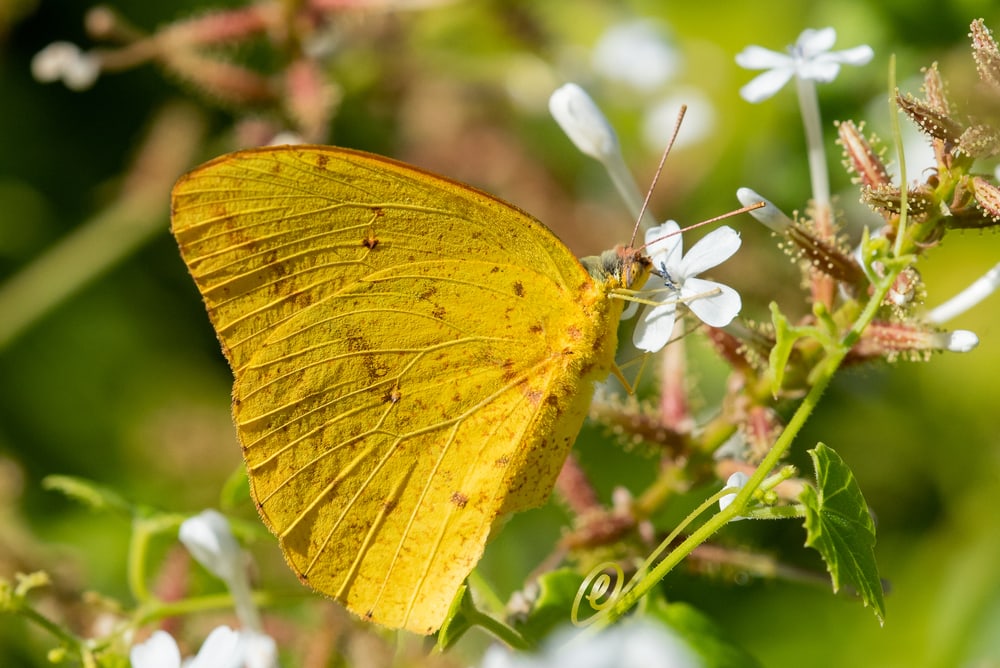
| Scientific Name: | Colias eurytheme |
| Wingspan: | 1.35 to 2.75 inches |
| Lifespan: | 2 to 4 weeks |
The name of Orange Sulphur may deceive you! These butterflies are not entirely orange but have various colors like yellow, white, and black. Their wings have yellow veins with orange overlaps and black borders.
These multi-colored butterflies are available across the state wherever they have accessible food sources, particularly in meadows and fields. Orange Sulphur caterpillars prefer feeding on plants from the Pea family, while adults feed on the nectar of dandelion, goldenrod, aster, and milkweed flowers.
5. Red-Banded Hairstreak
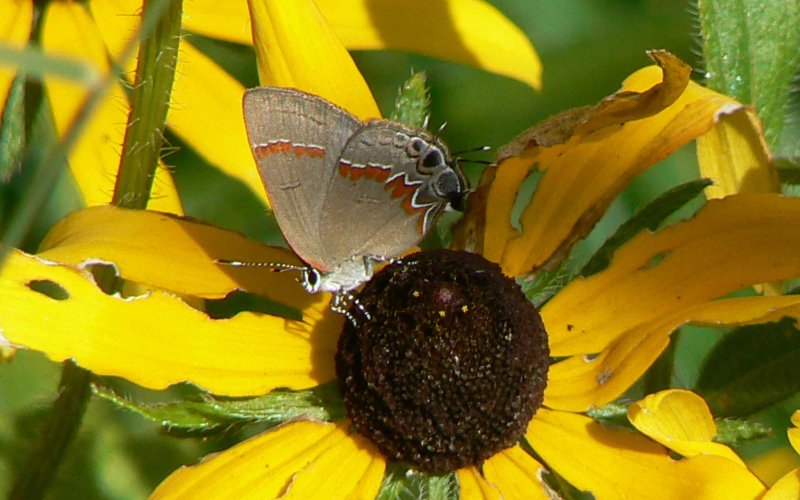
| Scientific Name: | Calycopis cecrops |
| Wingspan: | 0.87 to 1.25 inches |
| Lifespan: | 2 to 4 weeks |
The Red-banded Hairstreaks are reddish-orange butterflies with brown or bluish wings. They are relatively smaller butterflies found throughout North Carolina. The distinctive characteristic of Red-banded Hairstreaks is that they are migratory between April and October.
These butterflies prefer living in overgrown fields, forests, and coastal hammocks. When Red-banded Hairstreaks are caterpillars, they feed on fallen leaves of wax myrtle and oak trees. As they become adults, they look for nectar flowers, such as the tickseed sunflower, wild cherry, yarrow, sumac, common milkweed, and sweet pepperbush.
6. American Lady
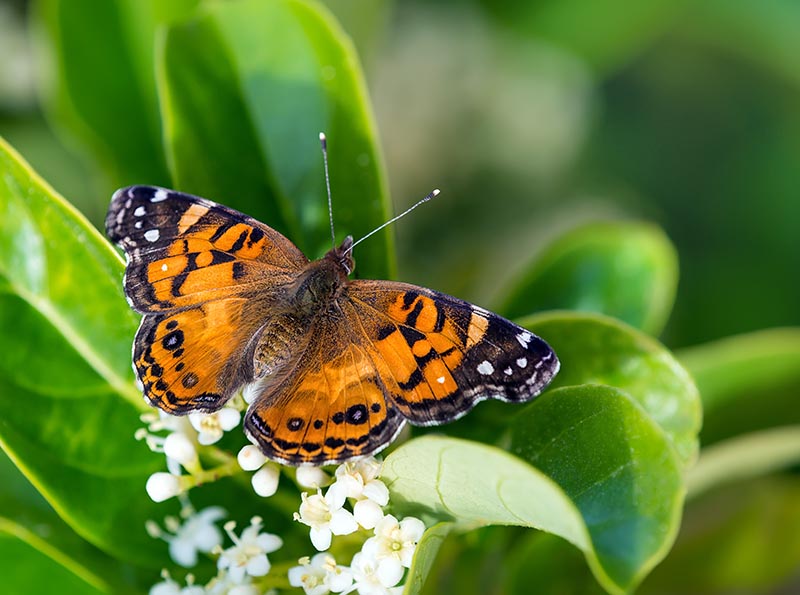
| Scientific Name: | Vanessa virginiensis |
| Wingspan: | 1.75 to 2.62 inches |
| Lifespan: | 2 weeks |
American Lady butterflies in warmer states are bigger and more colorful in summer than in winter. They have brown, yellow, and orange patterns on their bodies, with two eyespots on the hindwings. These distinctive butterflies are everywhere in the state where there is low vegetation.
The caterpillar American Lady feeds on plants belonging to the Sunflower family. However, the adults enjoy the nectar of dogbane, marigold, selfheal, aster, common milkweed, and goldenrod.
7. American Snout

| Scientific Name: | Libytheana carinenta |
| Wingspan: | 1.37 to 2 inches |
| Lifespan: | 2 to 4 weeks |
The American Snout is a brown and dull-orange butterfly species. They have distinctive white patterns on their wings. They’re named after their elongated mouth, called labial palpi, which looks like a snout.
These butterflies are everywhere in the state, from far western, southern, and central regions. To find American Snouts, you can look in clearings and forest edges. In their early stages, they feed on hackberry species, while adults feed on nectar flowers, including dogwood, dogbane, goldenrod, sweet pepperbush, and aster.
8. Silver-spotted Skipper
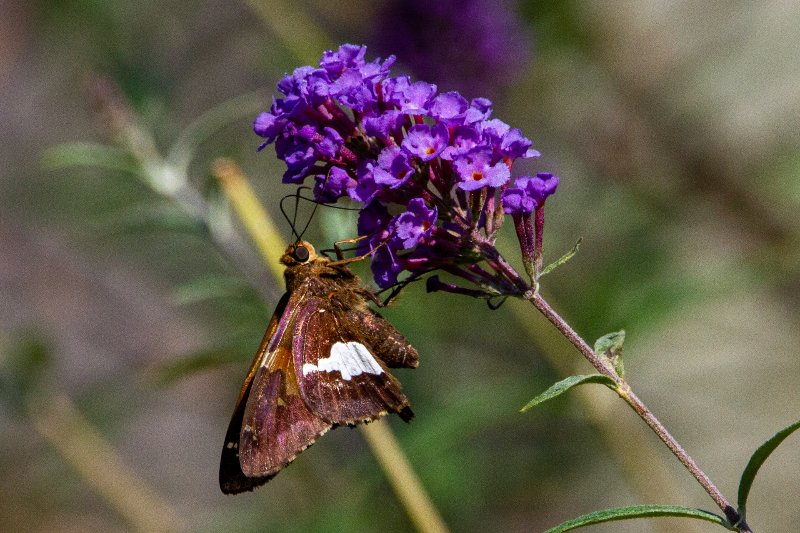
| Scientific Name: | Epargyreus clarus |
| Wingspan: | 1.75 to 2.62 inches |
| Lifespan: | 2 to 4 weeks |
The Skippers family consists of 68 butterfly species in North Carolina. One of them is the Silver-spotted Skipper. These butterflies are found across the state, identified by their distinctive brownish-black wings having gold spots and silver bands.
You’ll likely see Silver-spotted Skippers in their caterpillar stage in woody and herbaceous habitats. As adults, they feed on red, purple, blue, and pink flowers but never on yellow ones. The favorite flowers of Silver-spotted Skippers are everlasting peas, red clovers, blazing stars, thistles, and buttonbush.
9. Horace’s Duskywing
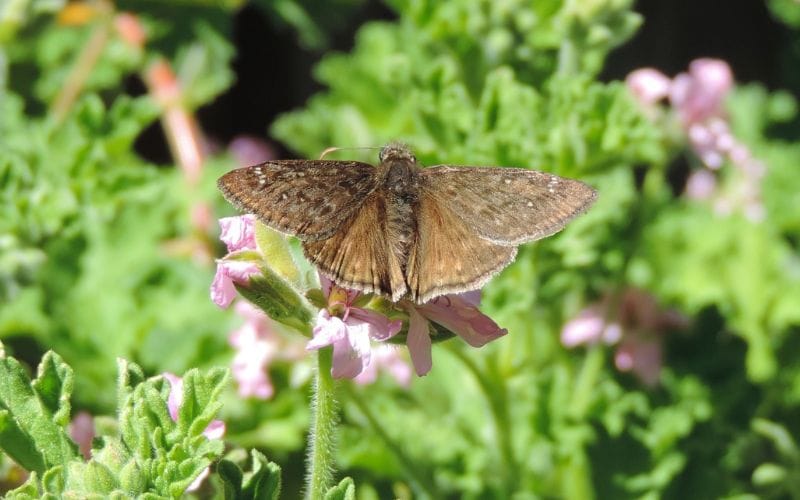
| Scientific Name: | Erynnis horatius |
| Wingspan: | 1.4 to 1.9 inches |
| Lifespan: | 2 to 4 weeks |
Like Silver-spotted Skippers, Horace’s Duskywings also belong to the Skippers family. These are dark brown butterflies with light brown shades on the wings. They are present throughout North Carolina, excluding many central-eastern counties and the border areas.
If you visit North Carolina between April and September, you may find Horace’s Duskywings in open fields and woodlands. As caterpillars, they feed on white and red oaks, while as adults, they feed on the nectar of flowers about 4.5 feet tall. These include buttonbush, boneset, peppermint, goldenrod, winter cress, and sneezewood.
10. Falcate Orangetip
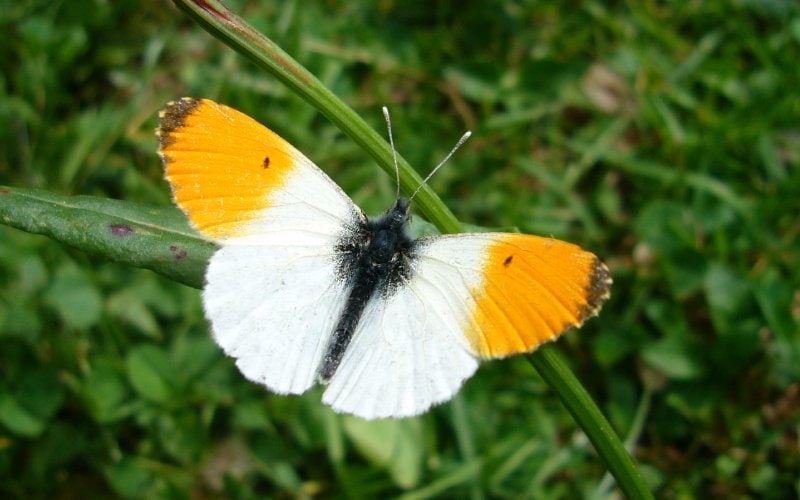
| Scientific Name: | Anthocharis midea |
| Wingspan: | 1.37 to 1.75 inches |
| Lifespan: | 2 to 4 weeks |
Not all Falcate Orangetip butterflies have an orange tip! They are white with a hooked tip that is orange only in males. Falcate Orangtips are present in every corner of North Carolina, from the mountains to the coast.
When caterpillars, these butterflies feed on plants (e.g., winter cress) belonging to the Mustard family. As they grow older, they shift to nectar flowers, such as mustards and violets.
11. Monarch Butterfly
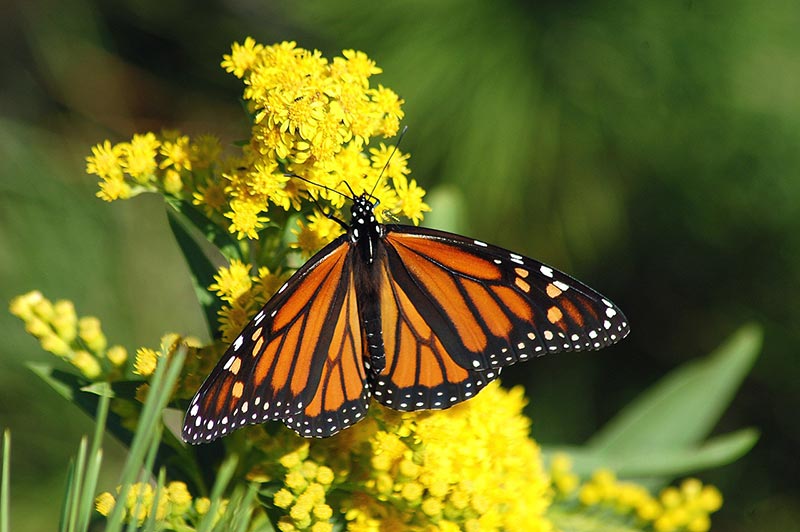
| Scientific Name: | Danaus plexippus |
| Wingspan: | 3.37 to 4.87 inches |
| Lifespan: | 2 to 4 weeks |
Monarch Butterflies inhabit North Carolina’s open habitats across the state. Not only North Carolina, but Monarch Butterflies are one of the most common species in North America.
These butterflies have a distinctive bright orange color adorned with black veins and borders. They are famous for their lengthy migration.
In both caterpillar and adult stages, Monarch Butterflies feed on milkweeds, which makes them poisonous. That’s one reason predators stay away from hunting these butterflies. Adult Monarch Butterflies also feed on the nectar of flowers, including lilac, dogbane, red clover, thistles, tickseed sunflowers, and blazing stars.
12. Summer Azure
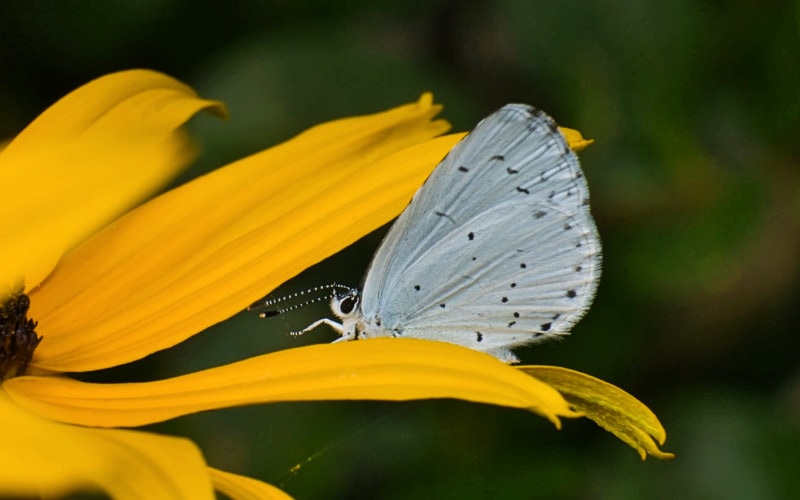
| Scientific Name: | Celastrina neglecta |
| Wingspan: | 0.9 to 1.1 inches |
| Lifespan: | 2 to 4 weeks |
Summer Azure is one of the five Azure species in the US. These are beautiful powdery-blue butterflies found across the state in different habitats, commonly in stream valleys and gardens.
Summer Azures are relatively small butterflies with a short lifespan. Between June and October, adults may live for only a few weeks. These butterflies feed on New Jersey tea and racemose plants in their caterpillar stage. As they become adults, they prefer the nectar of dills, clematis, buttercups, and bunch flowers.
13. Red-spotted Purple Admiral
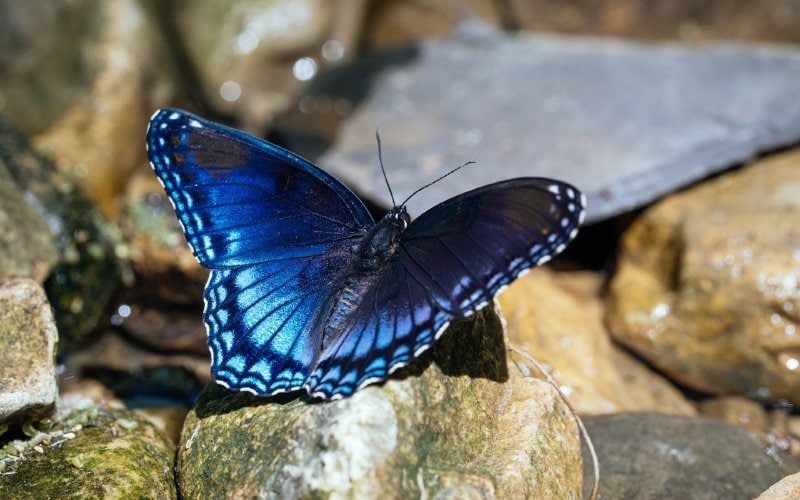
| Scientific Name: | Limenitis arthemis |
| Wingspan: | 1.25 to 4 inches |
| Lifespan: | 2 to 4 weeks |
Many people confuse Red-spotted Purple Admiral with White Admirals. However, both have a few differences, especially in color. The Red-spotted purple butterflies have bluish-green and dark-brown wings with red-orange pots and bars.
These butterflies are present across the state. Whether you visit forests, moist uplands, valley bottoms, or coastal plains, you will likely see them flying everywhere.
When Red-spotted Purple Admirals are caterpillars, they feed on shrubs and trees, such as willows, oaks, and cottonwood. As they grow older, they prefer feeding on tree sap, rotting fruit, dung, and nectar of small white flowers.
14. Eastern Tiger Swallowtail
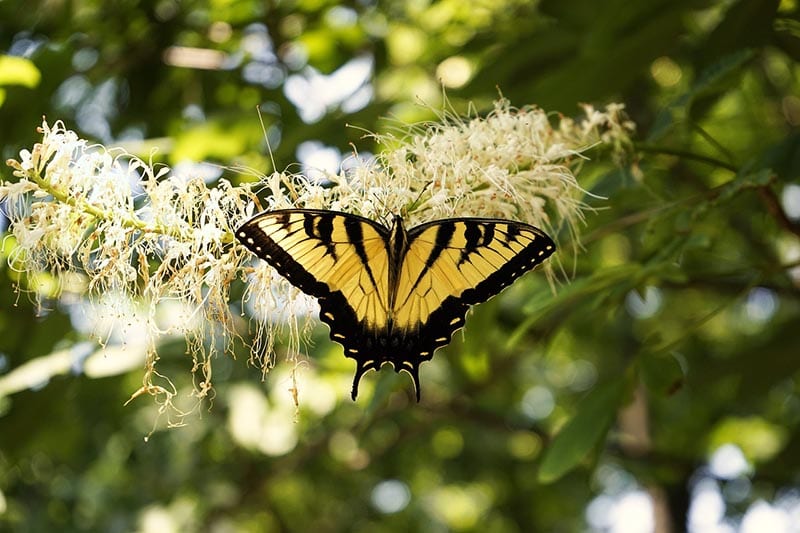
| Scientific Name: | Papilio glaucus |
| Wingspan: | 3.6 to 6.5 inches |
| Lifespan: | 2 to 4 weeks |
The Eastern Tiger Swallowtail gets its name after the “tails” present on the back of its wings that look like the tails of swallows. You can identify the males from the dark stripes and yellow wings, resembling a tiger. Females, on the other hand, are bluish-black with dark-colored stripes.
These butterflies are one of the common Swallowtails in North Carolina. The caterpillars feed on different leaves, including wild cherries, birches, tulip trees, cottonwoods, and sweet bays. The adults like the nectar of flowers, such as wild cherry and lilac.
15. Carolina Satyr
| Scientific Name: | Hermeuptychia sosybius |
| Wingspan: | 1.25 to 1.5 inches |
| Lifespan: | 2 to 4 weeks |
North Carolina has many Satyr species, including the Carolina Satyr. These butterflies are seen across the state, primarily in grassy and woodland areas. Their upper body is plain brown, while the underbody has small eyespots.
If you want to observe Carolina Satyrs, it’s better to take your binoculars to a nearby woodland or forest area. You’ll see caterpillars feeding on different types of grass, including Kentucky bluegrass and carpet grass. Meanwhile, adults prefer fruit rots and sap for their nourishment.
Conclusion
North Carolina is home to several unique butterfly species. Whether you’re a resident in the state or planning to visit soon, you should witness the greatness of the Monarch, Falcate Orangetip, Silver-spotted Skipper, and Little Yellow butterflies.
Remember the distinctive characteristics of the most prominent butterflies in North Carolina, so you can quickly identify them. All the species mentioned in this list are unique, colorful, and unforgettable.
Featured Image Credit: veronikasz, Pixabay
Contents
